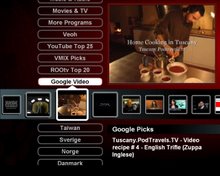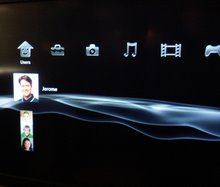The Issue: D-Link improves support for internet video access via its Apple-TV-like alternative.
Background: D-Link is adding active-TV technology to their DSM-520 networked media player. This will enable universal TV access to TV-web formatted internet distributed video.
Behind the scene: Access over the internet to materials specifically formatted for TV viewing should be as unrestricted as access to internet materials formatted for the PC browser. D-Link now makes this possible at a new low price via their innovation and market leadership.
D-Link is well known as a major supplier of networking technology. They also make a range of Digital Media Adapter (DMA) appliances which connect the living room TV into the home network. With broadband service to the home, the DMA gives any TV access to video over the internet. To be sure, this is similar to the operation provided by Apple TV – Apple’s DMA. An announcement on Tuesday at iTV Con, the Internet TV Technology Conference in San Jose, indicates that D-Link will add active-TV technology to their DSM-520 MediaLounge media player. With active-TV support, the DSM-520 will have access to a wide range of TV-web formatted video channels, and have an advantaged position when competition with Apple TV.

This is because adding active-TV technology means the DSM-520 is not limited to the TV User Interface (UI) incorporated into the box’s firmware. The TV UI is transmitted over the internet in TV-web format, just like a PC’s browser page-layout is provided in PC-web format. There is increasing use of TV-web formatting for internet video channel distribution. With a DSM-520 firmware upgrade, there will now be TV access to YouTube and other video sources such as Veoh, Vmix, BBC, Comedy Central and much more.

The DSM-520 is based on the EM8620 TV System-On-Chip (SOC) from Sigma designs. As with Apple TV and the latest generation of media players, there is support for High Definition (HD) video connections. Yet, unlike Apple TV, there is also support for older Standard Definition TV connections such as S-video and composite. There is also a USB port connection for access to photo, music or video materials retrieved from a USB-connected storage device. The EM8620 has support for the latest advanced video CODECs such as MPEG-4 and WMV.
.bmp)
We can anticipate active-TV technology will likely appear in other appliances in the existing D-Link product range. The iTV Con announcement indicated that D-Link will provide an active-TV technology firmware upgrade to existing DSM-520 owners. The Circuit City website currently shows the DSM-520 for sale at $179, which is currently only 60% of the base Apple TV price.
It is not unusual to see new appliances supporting access to internet video, tied back to a particular portal service; Such as the BT Vision Set-Top Box (STB) or the initial release of Apple TV. This may be driven by business interests. The plan could be to use the appliance to drive a revenue stream from the video accessed from the portal. The reasoning behind the plan may be an attempt to replicate a business model similar to that used by US cable TV industry. However, this business strategy is not applicable to a retailer of TVs or boxes such as the DSM-520.
I suspect the portal strategy is sometimes hidden behind a claim to “maintain UI standards”. That is the appliance supplier can’t guarantee the quality of operation from some user-chosen portal. Internet video consumers will eventually see thought this. For example, a Dell PC buyer does not expect the PC’s browser to only access Dell web sites, on the grounds that Dell.com can guarantee the quality of the web site. I am sure Dell does make its best efforts to build the best web site, but it can’t expect PC buyers to be restrained in such a way.
Similarly, TV retailers don’t try and sell TVs which can only access public broadcast channels because of their decision that, say, FOX channels are not adequate in quality, and hence should not be accessible.
In short, the same is true with TV-web access. For example, Apple TV can try assuring the standard of its own portal, but it can’t take responsibility for other developers TV-web material. Users likely don’t expect Apple to take on this responsibility, and equally they will expect Apple TV to ultimately support access to other TV-web internet addresses.
The D-Link DSM-520 with active-TV technology could be the platform that everyone wants because it enables universal access to TV-web. Using active-TV technology makes this possible. The DSM-520 will offer more choice than Apple TV and at a lower price. This is likely to remain the case until BroadQ introduce support for TV-web channels on the Sony Playstation 2. Naturally, this will cause further downward pressure on DMA pricing.
Internet video distributors can make use of TV-web formatting and the DSM-520 to offer video to the living room TV. This seems ideal for a retail product such as the DSM-520. I suggest for significant success as a retail product, there should be unrestricted access to any web-channel that may come along. Each video supplier, be it Veoh, Vmix or other, will work to ensure the quality of its video service. TV users, like PC users, understand these issues. There is always another HTML/Flash developer that thinks he or she can build a better UI layout. TV user would rather decide for themselves what internet video channels they want to watch; they will naturally avoid the bad and the ugly.
Feedback, corrections and comments welcome. Contact me for more information or support with active-TV technology development.
Daniel Mann













